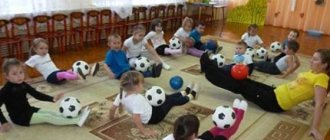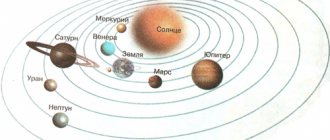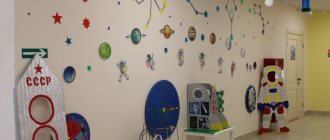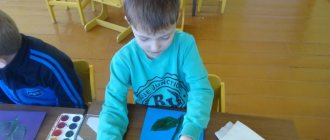Nursery rhymes
Folk nursery rhymes will amuse the baby during feeding and help the mother quickly feed the fidget.
***
Tilly-hour, Tilly-hour! Our lunch arrived. We eat a spoon for mom, We eat a spoon for dad, For the dog and for the cat, Sparrow knocks on the window: “Give me a spoon too!” So lunch is over.
***
Shirt, shirt, White-haired girl, Jumped on the threshold, Called guests. Guests, to the yard - Porridge, on the table, Guests from the yard - Porridge from the table.
***
The magpie-crow cooked porridge, fed the children, gave it to this one, gave it to this one, - Where were you? He didn’t chop wood, he didn’t light the stove, he didn’t cook porridge, he came later than everyone else.
***
A horned goat is following the little guys. Who doesn't eat porridge? Doesn't drink milk? Gore, gore, gore!
*** I bake, bake, bake, The kids all have a pie, And for my dear mother I’ll bake two gingerbread cookies. Eat, eat, mommy, two delicious gingerbread cookies. I'll invite the kids and treat them to pies -
Eat, please!
***
Lyuli, lyuli, lyuli, The ghouls flew in, The ghouls began to coo, The ghouls began to fuss: They flew into a corner, They lit a fire, They began to cook porridge, They began to feed Masha.
***
Slowly, little by little, little by little, slowly, We ate porridge with you, Isn’t the porridge good?! This is a spoon, this is a cup, There is buckwheat porridge in the cup. The spoon was in the cup, the buckwheat porridge was gone.
***
Who is our favorite? - The first spoon is for mom, and the second is for whom? - Yes, for your dad, for whom the third spoon? - For a cheerful nesting doll, Eat for a woman, Eat for a grandfather, For a boy - for a neighbor, For girlfriends and friends, Eat more and don’t regret it! Eat for the holiday, noisy, bright, For the guests and for the gifts, For the kitten, for Timoshka This little spoon And for the red cat, Here the plate is empty!
***
The delicious porridge is steaming, Dasha sits down to eat the porridge, the porridge is very good, they ate the porridge leisurely. Spoon by spoon, Ate a little at a time.
*** Duck duckling, Cat kitten, Mouse little mouse Calling for lunch. The ducks ate, the cats ate, the mice ate. Have you not yet? Where's your spoon? Eat at least a little.
*** The donut, the flatbread, sat in the oven, looked at us, and wanted to put it in my mouth.
***
Till-hour, tick-till-hour, we're having lunch now We'll eat a spoon for mom, We'll eat a spoon for dad, For the dog and for the cat, the sparrow is knocking on the window, give me a spoon too... so lunch is over.
*** Lyuli, lyuli, lyulenki, The ghouls flew in, The ghouls began to say: “What should we feed Sonechka?” One will say: “porridge”, Another – “yogurt”, The third will say – “milk, And a ruddy pie.”
***
Our Vanyusha is a fidget and won’t finish his lunch. They sat down, stood up, sat down again, and then ate all the porridge.
*** Oh, lyuli, lyuli, lyuli, ships sailed into the sea, they brought porridge to Masha. Kasha's little milk For my beloved daughter. Masha, open your mouth, swallow the sweet porridge. And whoever eats porridge, listens to mom and dad, grows up strong, healthy and beautiful.
***
Am! Am! Am! I'll give you candy, But first, for our mother, eat a spoonful of semolina porridge! Am! Am! Am! Eat the porridge yourself, Vanya! Eat a spoonful for daddy, you'll grow up a little more! Am! Am! Am! If you don't eat, I'll eat it myself. And I’ll grow a whole mile with every spoon! I will become completely big, and then I will eat you!
Long-term planning in the first junior group in the field of fiction
Long-term planning in the first junior group in the field of fiction
| Month | A week | Subject | Program content | Methods and techniques | Materials and equipment | Literature |
| September | I | Reading the nursery rhyme “Bay, bye, across the river” | Arouse interest in folklore; explain the content of a poetic work; involve in the performance of a nursery rhyme; teach how to perform actions in accordance with the text. Contribute to the development of intonation expressiveness of speech. | Creating a game situation. Round dance game "Loaf". Reading a nursery rhyme. Conversation on issues. Dramatization of the work. Repeating the nursery rhyme with the children. | A screen in the shape of a house with decorations: the sun is hiding behind the river; the inside of the bedroom is a bed with a picture of a sleeping child; Andryushka doll; bunny hats for each child. | — “Activities with children 2-3 years old” p. 47, lesson 1. — Book for reading in kindergarten 2-4 years old, p. 17. |
| III | Reading the nursery rhyme "Boo-boo-boo - I'm horned." | Arouse interest in folklore; teach to understand the content of a poetic work; develop the emotional sphere, auditory attention, speech activity. Cultivate a love for your native language. | Game moment. Reading a nursery rhyme. Game of "goats". Reading nursery rhymes with children. | Bibabo goat toy; table screen. | — “Classes with children 2-3 years old” p. 48, activity. 2. — “Comprehensive classes in 1 ml. gr. d.s.”, page 84, title 2. | |
| October | I | Reading the nursery rhyme “Like our cat” | Help children understand the content of the nursery rhyme. Make you want to listen to the nursery rhyme again. Learn to concentrate, promote an emotional response to the content of the nursery rhyme. Cultivate a friendly attitude towards animals. | Game moment. Reading a nursery rhyme. Conversation on issues. Physical education minute. Reading nursery rhymes with children. Children playing with a cat. | Soft toy cat. | -, “Classes with children 2-3 years old” p. 48, class. 3. V. - V. Gerbova, p. 98, title. 56. , “Comprehensive classes in 1 ml. gr. kindergarten" p. 100, room 2. -Reading book, page 8. |
| III | Reading the nursery rhyme “I’m going, going, to grandma, to grandpa.” | Learn to listen and understand the content of a nursery rhyme. Arouse interest in folklore; learn to concentrate, engage in play activities suggested by the teacher; promote an emotional response to the content of the nursery rhyme. Cultivate respect for adults. | Creating a game situation. Reading a nursery rhyme. Conversation on issues. Physical education minute. Reading nursery rhymes with children. | Wheeled horses. Grandfather and woman are characters in a puppet theater. Gifts: scarf and belt. | -, “Classes for children 2-3 years old” page 50, title 4. — , “Comprehensive classes in 1 ml. gr. kindergarten" page 104, lesson 1. — Reading book, p.9. | |
| November | I | Reading of S. Cherny’s poem “Pristavalka”. | Involve in dialogue with adults; develop and activate children's vocabulary; master the structure of a simple sentence. | Game moment. Reading a poem. Conversation with children. Reading the nursery rhyme “Bye-bye, across the river.” Children playing with a doll. | Toys: boy doll, cat, bird, frog; doll bed | -Reading book, page 110, — , “Classes with children 2-3 years old” p.52, lesson 5. |
| III | Reading the poem by E. Blaginina “Dine” | Teach children to understand speech addressed to them, to respond to the address using available speech means; develop and activate the vocabulary, include familiar actions in it. Cultivate a love for animals. | Reading a poem. Conversation on issues. Physical education minute. Children's games with the characters of the poem. | Doll Masha, toy dog, cat, chicken, plate, bowl, saucer, crock, table, chair, tablecloth. | -, “Classes with children 2-3 years old” p.54, lesson 6. | |
| December | I | Reading the nursery rhyme “White-legged Goat” | With the help of a nursery rhyme, make your first acquaintance with a goat and a wolf. Emotionally and vividly highlight the triumph of the good beginning; cultivate humane feelings; promote aesthetic enrichment using the artistic possibilities of folklore words and visual aids (illustrations). | Looking at the album. Conversation based on pictures. Reading a nursery rhyme. Physical education minute. Together with the children, sing about Kozushka - the white-legged one (to the tune of the Russian folk song “Barynya”) with clapping to the beat of the melody and playful movements with the hands (flashlights). | Album with “surprise” pictures. | -, “Classes with children 2-3 years old” p.56, lesson 7. — , “Comprehensive classes in 1 ml. gr. kindergarten" page 145, exercise 2. |
| III | Reading the nursery rhyme “As if three sleighs were flying through the snow, through a blizzard.” | Continue to introduce children to small folklore genres that reflect elements of folk life. Use toys to concentrate attention; promote an emotional response to the content of the nursery rhyme; learn to engage in play activities suggested by the teacher. | Conversation about the season - winter. Reading a nursery rhyme. Acting out a meeting scene. Children dance together with the characters (children stomp their feet, squat, clap their hands). | Children's toy sleds for dolls, cardboard horses, puppet theater characters (grandmother, grandfather, auntie, girl Katya). | -, “Classes with children 2-3 years old” p.58, lesson 8. T. - M. Bondarenko, “Comprehensive classes in 1 ml. gr. kindergarten" page 149, lesson 1. | |
| January | I | A dramatization of the Russian folk tale “The Little Goats and the Wolf.” | Maintain speech activity and initiative, the desire to engage in verbal communication; based on the fairy tale, expand ideas about the relationship between mother and children; strengthen maternal authority, instill obedience; using the example of the images of the Goat and the Wolf to show the confrontation between good and evil; confirm the triumph of a good beginning. | Game situation. Showing a Goat with kids. Telling a fairy tale. Fairy tale dramatization. Singing the Goat song. | Puppet theater characters: wolf, goat, kids (2-3 pcs.), Goat's hut. | — “Classes with children 2-3 years old) p. 61, lesson 9. |
| III | Reading the nursery rhyme “Cucumber, cucumber” | Expand children's vocabulary through words with the same root that have different connotations - “cucumber”, “cucumber”, “cucumber”; introduce the folklore character - the mouse, giving the image realistic features. | Game situation. Reading a nursery rhyme. Physical education minute. Game moment of a mouse chasing a cucumber. Reading nursery rhymes with children. | Toy - mouse, cucumber model. | — “Classes with children 2-3 years old” p. 62, activity. 10. | |
| February | I | Reading the nursery rhyme “Grandfather Yegor is riding from behind the forest, from behind the mountains.” | To consolidate and expand children's knowledge about domestic animals, their importance in people's lives (they ride a horse, a cow gives milk, etc.); introduce a new folk genre - nursery rhymes - fables. Let children feel the curiosity of the situations described, their humor. | Conversation about pets. Reading a nursery rhyme. Playing a nursery rhyme - a fable with characters shown on a flannelgraph. Physical education lesson (show how grandfather Yegor rode a horse). Conversation on the content of the nursery rhyme (is it possible to ride a cow and kids). Reading nursery rhymes with children. | Flannelograph; drawn compositions (grandfather Egor on a horse, grandmother on a cow, children on calves, grandchildren on kids); a set of toys from the book "Animal Farm". | — “Classes with children 2-3 years old” p. 65, lesson 11. — “Comprehensive classes in 1 ml. gr. kindergarten", p. 184, entry 1. |
| III | Reading the nursery rhyme “Goat Trouble.” | Consolidate and expand knowledge about domestic (goats and kids) and wild animals (wolf, bear and fox); pay attention to their distinctive features. Highlight the image of a goat - a kind and wise mother who protects her children. | Look at animals with children and talk about them. Reading a nursery rhyme. Reading nursery rhymes with visual accompaniment. Game with animal figures “What has changed?” | Planar images of animals (goats, kids, wolves, bears, foxes), flannelgraph. | — “Classes with children 2-3 years old” p. 67, lesson 12. — “Comprehensive classes in 1 ml. gr. kindergarten", page 189, chapter 1. | |
| March | I | Tabletop theater "Teremok". | Teach children to listen to a fairy tale, distinguish animals by appearance, and name them correctly. Teach children to take part in the dramatization of a fairy tale, to form intonational expressiveness of speech. | Showing animals from a fairy tale. Invite children to listen to a fairy tale about these animals. Telling a fairy tale, accompanying the story with a show of theater characters. Children playing with fairy tale characters. | Characters of the fairy tale "Teremok" from the theater "Bi-ba-bo" (mouse, frog, bunny, fox, wolf, bear), house. | — “Comprehensive classes in 1 ml. gr. kindergarten" p. 234, room. 1. |
| III | Reading the nursery rhyme “How I love my little cow.” | Reveal the special attitude to the “cow”, “mother cow”, “nurse cow” in Russian folklore; create vivid images associated with folk art. | Examination of Dymkovo toys (“cows and young ladies”). Compiling a panorama to dramatize the text of a nursery rhyme song. Reading a nursery rhyme. Physical education minute. Reading nursery rhymes with children. | Dymkovo toys (“cow”, “young lady”); grass, tub. | “Classes with children 2-3 years old” p. 68, lesson 13. | |
| April | I | Reading of A. Brodsky’s poem “Sunny Bunnies.” | Learn to understand poetic works; get involved in the game based on the content of the poem; create a joyful mood in children. | Game with sunbeams. Reading a poem. Game moment with searching for a sunbeam. Repetition of the poem. | Small mirror. | — “Classes with children 2-3 years old” p. 70, lesson 14. |
| III | Lesson using folklore works “The Shepherd and the Cow.” | To consolidate and expand children's knowledge about pets. Introduce a new word “shepherdess”, act out scenes with toys, using folklore texts. | Game situation. Reading familiar poems, nursery rhymes and songs about a cow. Children playing with toys. | A doll depicting a shepherdess, toys - cows according to the number of children. | — “Comprehensive classes in 1 ml. gr. kindergarten" p. 219, room. 1. | |
| May | I | A dramatization of the fairy tale "Kolobok". | Help children understand the content of the fairy tale, encourage them to pronounce the words in the kolobok song; make you want to listen to the story again. Contribute to the development of intonation expressiveness of speech. | Game situation. Telling a fairy tale. Conversation on the content of the fairy tale. Physical education minute. Dramatization of a fairy tale. | Flannelograph; toys. | — “Classes on speech development in the first teens. gr. kindergarten" page 75, section 49. |
| III | Reading the story “Chicken” by E. Charushin. | Learn to understand the content of literary works; master forms of monologue speech; develop the ability to talk about emotionally significant events in 2-3 sentences. | Game situation. Reading a story. Conversation on the content of the story. Physical education minute. Retelling what you read with the participation of children. | Flannelograph; figurines of hen and chicks. | — “Classes with children 2-3 years old” p. 71, lesson 15. |
Literature:
1. “Classes for children 2-3 years old” Creative Moscow 2010,
2. “Comprehensive classes in 1 ml. gr. kindergarten "Publishing house "Teacher" Voronezh 2003,
3. “Classes on speech development in the first teens. gr. kindergarten" "Enlightenment" Moscow 1986.
Get text




